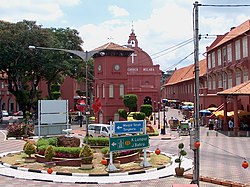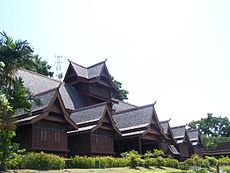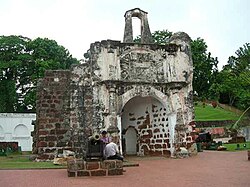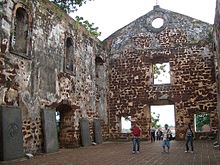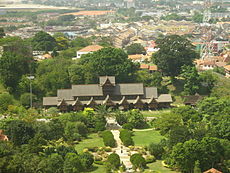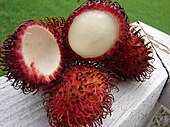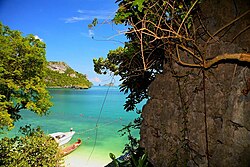Kinabalu National Park or Taman Negara Kinabalu in Malay, established as one of the first national parks of Malaysia in 1964, is Malaysia's first World Heritage Site designated by UNESCO in December 2000 for its "outstanding universal values" and the role as one of the most important biological sites in the world with more than 4,500 species of flora and fauna, including 326 bird and around 100 mammal species.
Located on the west coast of Sabah, east Malaysia on the island of Borneo; it covers an area of 754 square kilometers surrounding Mount Kinabalu, which at 4,095.2 metres, is the highest mountain on the island of Borneo.
 The park is one of the most popular tourist spots in Sabah and Malaysia in general. In 2004, more than 415,360 visitors and 43,430 climbers visited the Park. The region was designated as a national park in 1964. British colonial administrator and naturalist Hugh Low led an expedition from Tuaran to the region in 1895. He also became the first recorded man to reach the peak of Mount Kinabalu. The highest peak of the mountain was later named after him—Low's Peak.
The park is one of the most popular tourist spots in Sabah and Malaysia in general. In 2004, more than 415,360 visitors and 43,430 climbers visited the Park. The region was designated as a national park in 1964. British colonial administrator and naturalist Hugh Low led an expedition from Tuaran to the region in 1895. He also became the first recorded man to reach the peak of Mount Kinabalu. The highest peak of the mountain was later named after him—Low's Peak.Kinabalu Park is situated on the Crocker Range on the western coast of Sabah. It is located within the district of Ranau, within the West Coast Division. The park is not to be confused with Crocker Range National Park which is a separate park in the south.
The park headquarters is 88 kilometers away from the city of Kota Kinabalu. There are highways and sealed roads leading towards the park headquarters from other parts of Sabah. It is situated on the southern boundary of Kinabalu Park, at an elevation of 1,563 m (5,128 ft).
The park headquarters is 88 kilometers away from the city of Kota Kinabalu. There are highways and sealed roads leading towards the park headquarters from other parts of Sabah. It is situated on the southern boundary of Kinabalu Park, at an elevation of 1,563 m (5,128 ft).
This park is administered by an organization called Sabah Parks. Accommodations in the form of chalets can be found in the park, mostly around the headquarters. Reservations for accommodation and mountain climbing guides are processed through Sutera Sanctuary Lodges (also known as Sutera Harbour), a private company. Every person who wishes to climb the mountain must be accompanied by a qualified guide. Sutera is now requiring hikers stay one night at their lodge near the entrance, in addition to a required stay at Laban Rata. The cost to stay is considerably higher than at lodging just outside the park, and includes a mandatory purchase of meals, etc.
The mountain summit trail begins at Timpohon. There is also an alternative route called the Mesilau Trail. A notable feature of the park is Low's Gully. It is a 1.6 kilometre deep ravine stretching 10 kilometres on the side of the mountain peak.
The mountain summit trail begins at Timpohon. There is also an alternative route called the Mesilau Trail. A notable feature of the park is Low's Gully. It is a 1.6 kilometre deep ravine stretching 10 kilometres on the side of the mountain peak.
This botanical site contains a variety of flora and fauna that ranges over 4 climate zones; from rich lowland dipterocarp forest through the montane oak, rhododendron, to the coniferous forests, to the alpine meadow plants, and to the stunted bushes of summit zone. The mountain is also known for its many carnivorous plant and orchid species, most notably Nepenthes rajah.
It is also home to a multitude of endemic animal species, including the Kinabalu Giant Red Leech and Kinabalu Giant Earthworm. The park also plays host to a variety of birds, insects, mammals, amphibians, and reptiles.
Mount Kinabalu is one of the youngest non-volcanic mountains in the world. It was formed within the last 10 to 35 million years. The mountain still grows at a rate of 5 millimetres a year. Mount Kinabalu is in Kinabalu Park in the Malaysian state of Sabah, some 80 km east of Kota Kinabalu.
Mount Kinabalu is Borneo's tallest mountain. You can climb to the top of Low's Peak (4,095.2m or 13,435.7ft above sea level). The height of the mountain is often given as 4,101m but recent satellite imaging has proven this to be incorrect.
The mountain is sacred to locals. They believe that spirits of their ancestors inhabit the top of the mountain. Previously, a chicken was sacrificed at the peak every time a climb was made but these days this ceremony only happens once a year when only seven chickens are needed to appease the spirits.
Mount Kinabalu is known to be one of the most accessible mountains in the world. No specialized mountain climbing skills are required to ascend it. The trail that most tourists use is described as a 'trek and scramble'. Locals begin climbing the mountain from the age of 3 and the oldest person to reach the peak was 80 years old. However, how much one enjoys the climb depends strongly on how fit you are and how well you acclimatize to the thin air at the higher levels.
Nevertheless, the mountain can be a dangerous place, especially during the rain or when there is mist. On average, every year one person gets into severe difficulty out of the estimated 20,000 people who attempt the climb. The higher slopes can be very slippery when it rains and dense fog reduces visibility to a few feet.
 Although it is possible to climb to the top and back in less than four hours, most climbers take two days, with an overnight break at Laban Rata (3,272.7m above sea level). The final attack on the peak takes place in the early hours of the second day (most begin at 2:30AM) in order to catch the sunrise at the top. By mid-morning the mist begins to roll in, obscuring the breath-taking views.
Although it is possible to climb to the top and back in less than four hours, most climbers take two days, with an overnight break at Laban Rata (3,272.7m above sea level). The final attack on the peak takes place in the early hours of the second day (most begin at 2:30AM) in order to catch the sunrise at the top. By mid-morning the mist begins to roll in, obscuring the breath-taking views. Climbing weather is best around the month of April while November and December brings rain. The temperature ranges from a comfortable 20-25°C at the main park to something approaching freezing near the top (depending on the weather). Bring clothing appropriate or else you will get cold and be miserable. If possible, climb during the full moon as it helps illuminate the white rope that marks out the climbing path.
http://wikitravel.org/en/Mount_Kinabalu
Images: http://commons.wikimedia.org/wiki/Category:Mount_Kinabalu














